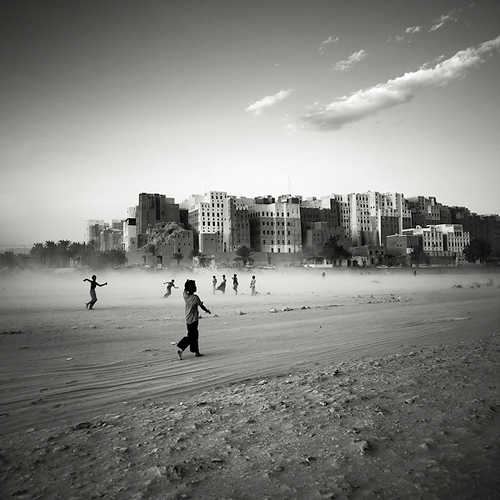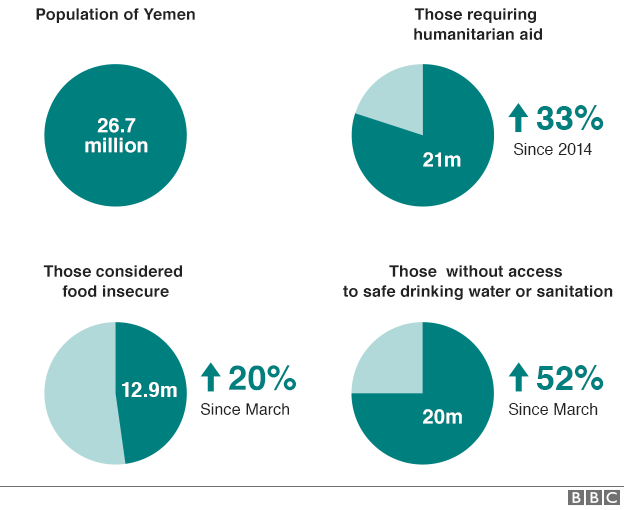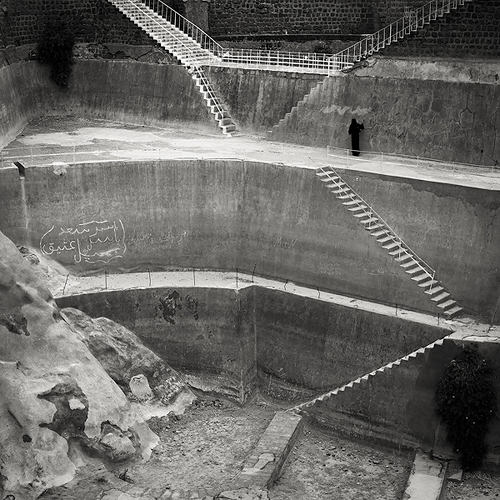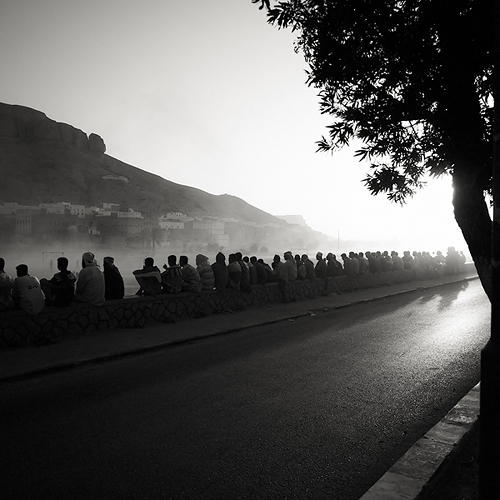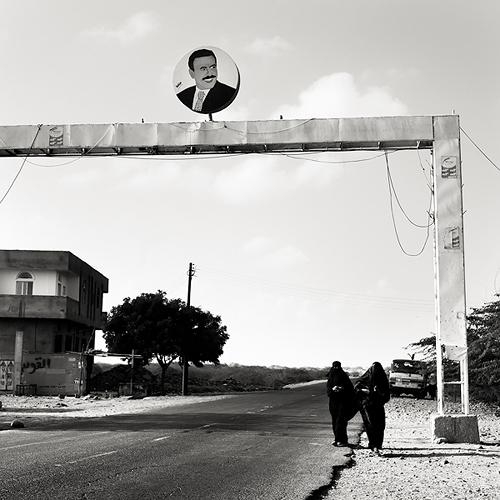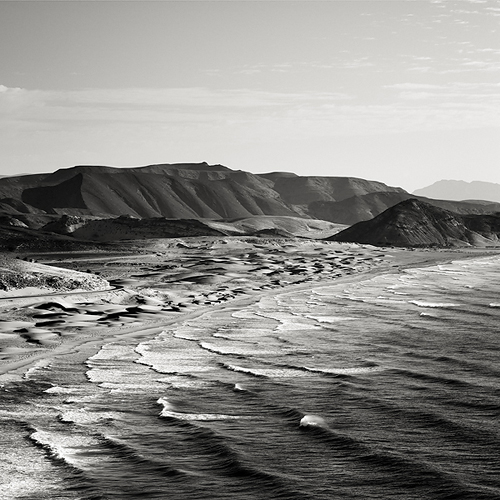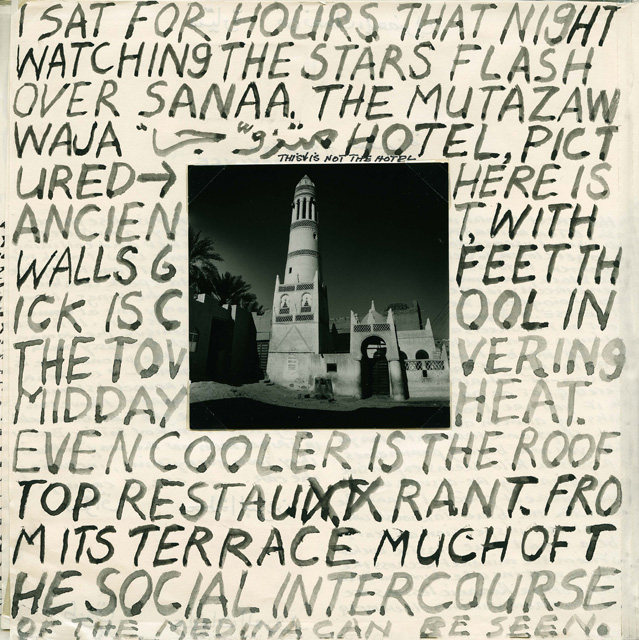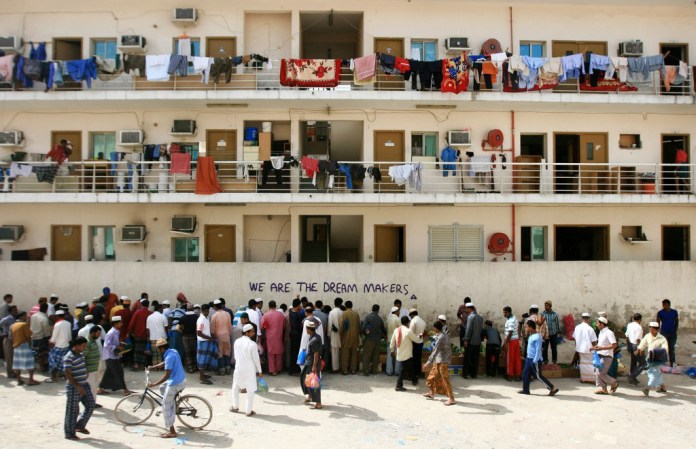 /We are the dream makers, Dubai by Arcadia Blank/
/We are the dream makers, Dubai by Arcadia Blank/
Laleh Khalili is professor of Middle East politics at the School of Oriental and African Studies in London. She is the author of Heroes and Martyrs of Palestine: The Politics of National Commemoration (Cambridge, 2007) and Time in the Shadows: Confinement in Counterinsurgencies (Stanford 2013), and the editor of Modern Arab Politics (Routledge 2008) and co-editor (with Jillian Schwedler) of Policing and Prisons in the Middle East: Formations of Coercion (Hurst/Oxford 2010).
Khalili’s most recent research projects deal with the politics and political economy of war and militaries as it intersects with infrastructure, logistics and transport with specific focus on the Middle East.
Your book Time in the Shadows: Confinement in Counterinsurgencies deals with continuities in counterinsurgencies, with the way tactics of war shifted to elaborate systems of detention and encouraged policy makers to willingly choose to wage wars. Doing the research for this book, what were the biggest discoveries for you personally?
The moment I decided to do the project was one of those great epiphanies. I was doing the final research on my first book, which was about Palestinian refugees. I was talking to a Palestinian man who was raised in Lebanon and served as a PLO fighter during the Lebanese civil war. He was captured and held in prisons inside Israel. Around the same time I was interviewing him, the Abu Ghraib pictures were published. He told me it was difficult for him to look at those pictures because he was also kept naked, and dogs were used to intimidate him while he was imprisoned. It was a surprise for me to hear that.
Why was it surprising?
We often hear about different methods of torture that don’t leave marks used in these prisons, but the fact that there were other things, like dogs and nakedness, really interested me. When I started working on the project, which was originally about the different kinds of detention practices, the more I started to read, the more it became clear to me that this is not random. There is a particular way in which states that claim to be liberal, that claim to be following the rule of law and discourse of human rights, use particular methods of subjugation that seem to repeat across different contexts.
This was as true of the British and the French in the 19th and 20th centuries, and finally to Americans and Israelis nowadays. There are actual channels through which these forms of oppression travel. Finally, what became clear to me was that the more you made the war liberal in situations where people have a democratic say about the conduct of war, the more you fight a “humane” war, the better it is for arguing in favour of war. You can say you’re going to have a nice war, but in the end there’s no such thing as a nice war.
Just last week, more than a thousand Palestinians in Israeli prisons launched a hunger strike, demanding better living and medical conditions for approximately 6,500 prisoners. Unlike similar instances in the past, this hunger strike is being reported on by the mainstream media. How did the situation change from the time you did the research for Time in the Shadows, do you think there’s more media space for these issues now?
The media space for Palestinians opens and closes cyclically and it depends on what else is going on in the world. Between the time I began the research on the book and now there has been a space opening up for discussion about the kinds of atrocities that are committed. It’s also important to say that the politics around Israel and conditions of Palestinians inside Israel and under Israeli settler colonialism, and the way the media chooses to portray that have shifted.
This shift has less to do with counterinsurgencies and wars being fought and more to do with the successes Boycott, Divestment and Sanctions (BDS) struggles have had in trying to find a voice in which Palestinians don’t get sidelined, in which the conditions they live in are amplified in European and North American media. That plays a significant role in us being able to hear about the hunger strike of prisoners.
One of the issues you deal with in Time in the Shadows is what happens when states expand beyond their borders. For the last couple of years in Europe, in dealing with the so-called refugee crisis, we are witnessing the externalization of borders, not just in relation to third countries, but also within EU member states themselves. How does this re-articulation of border management practices, the formation of new institutions and policies, affect the ideas of nation-states, jurisdiction and sovereignty?
There are particular ways in which forms of control that were used externally are being used on refugees who are within the borders or are trying to cross the borders. The jurisdictional power now attaches to bodies. We get to move around Europe easily because of our citizenship, because of the rights attached to our passport. The absence of rights attached to that passport makes us profoundly vulnerable to different forms of coercion. The border is no longer a line on the map, it’s not a geophysical feature of the territory, but rather something that happens crosses the body of the person. The border ends up being me, ends up being you. That is one of the ways this externalization is being brought home.
What are the other ways?
There’s more of them, and they don’t have to do only with migrants. Domestic policing is being militarized and the kinds of tactics that were used in counterinsurgencies are being brought home in North America and Europe. They are used in counterterrorism operations against both citizens and those perceived to be outsiders, whether or not they are citizens. Entire communities are subjects of these new kinds of policing, based on their religion, skin color, etc.
Bringing home of the external violence is fascinating – we see armoured vehicles being used in domestic demonstrations. But that is inevitable – when you’re waging big wars, it’s only a matter of time when those war methods and equipment will be used at home. And people of course, a lot of ex-soldiers become police officers and prison wardens.
In connection to what you mentioned before in regard to citizenship, Arjun Appadurai makes an interesting point how most of the citizenships laws we have today are based in the past, in blood, parenthood, etc. For a change to happen, he argues, we would need to think about citizenship based on the imagined future, on aspirations. Do you think there are possibilities for this sort of a citizenship narrative to become a part of the mainstream discussion?
The idealist in me would like to see more space for that, but looking at the way belonging is often used as means of exclusion, limiting access, limiting the ability to dream, it’s hard for me to imagine that sort of citizenship in practice. It’s interesting to think about aspirational forms of citizenship, and the dream of belonging, but I am not entirely sure without actual concrete instruments how to transform it into reality. It’s still important to remember that all forms of belonging draw borders, even the aspirational, future oriented belonging. All dream worlds come with attached catastrophes. It is important to think about what we aspire to, because the aspiration itself is not enough. The content of it is what matters.
In your recent projects you deal with the political economy of war and militaries and the way it intersects with infrastructure, logistics and transport. Your specific focus is on the Middle East. How did you come to this point in your career, where is the continuity with your previous work?
There are two things that brought me here. I was interviewing a US military officer about matters of counterinsurgency, and he said: “Oh, you academics and journalists, you all love everything that bleeds”. To really understand the war, he said, you need to look at military logistics, that’s where all the money is spent. That was the first signal that got me looking in that direction. The vast majority of US military budget around the war is spent on getting the fuel to the fighters, getting food, setting up where they live, getting the uniforms and ammunition. Food and fuel tend to be the biggest logistical expenses. There is an entire machinery behind that.
The second thing was that friends who work for the International Transport Workers’ Federation were interested in finding out more about the Arabian peninsula, and they encouraged me in this direction. It was a combination of wanting to find out more about the role of military logistics, and about the working conditions of people in these maritime settings in the Arabian peninsula. The Arabian peninsula was perfect for this because Kuwait and Qatar were staging grounds for the American war in Iraq, and the UAE continues to be a logistical staging ground for the US war in Afghanistan.
You’re primarily interested in the role of US and British military and oil companies in the Arabian peninsula. In which ways do the policies of these countries affect the infrastructure of the Arabian peninsula, and specifically the working conditions of people employed in the ports and maritime transport business?
It depends on the country. In Saudi Arabia, the role of the US is much more important than the role of the British, while in the smaller Emirates, as well as Oman and Yemen, the role of the British is much more important due to colonial history. Emirs in these countries continue to be advised by the British and to a certain degree the indirect colonial control continues today. The US and GB didn’t only have a substantial role in the structure of these states.
Oil companies and tanker terminals have a different history, but it is very crucial to the formation of these states and their transport infrastructures. The conditions of work that emerged in tanker terminals, the geographic placement of these terminals far from cities, the way they were automated from very early on, in the 1940s and 1950s, have been essential in shaping practices within container industries many years later.
The second thing that has been really interesting is that the oil companies, in order to be able to start extracting oil in the Arabian peninsula, have to bring in all the materials, pipes, heavy equipment. They couldn’t do that because many of these ports simply didn’t allow for ships to come close enough, particularly in the Gulf area, where the coast is very shallow and tends to be mudflat, with no deep harbours. They had to build new ports and that shows the connection of the cargo history with oil companies.
In your lectures you often talk about the significance of Yemen and the city of Aden as a port, and the changes it went through in the recent history. Why is Aden so significant?
Aden was a British colony from 1834 to 1967. It was originally colonized because the British needed a coaling station in that location, but also the British wanted to colonize that area because of the location close to the Red Sea, and the East African coast and of course to India. With the opening of the Suez Canal in the mid-19th century, Aden became far more significant than it has been before. That’s when it becomes the fourth largest coaling station for ships in the world. There’s a long history of Yemen being on these trade routes, because it was a hub for coffee. Mocha coffee we know today is named after a port there.
After 1950s when the British lost their big refinery in Iran, because it was nationalized, a major refinery was built in Aden. The rise of Aden as a port continues until British are forced to leave by the anti-colonial struggle which begins in the late 1950s. The British didn’t want to give up Aden, it was a major city, cosmopolitan, of strategic importance, and crucial to the conduct of empire, but later in the 20th century Americans are stepping into the game.
What has happened in the last decades is fascinating because now regional capital is injecting money into Aden, money from Dubai and so on. The deals that these companies are making are corrupt. Aden ended up taking Dubai Ports World, one of the biggest terminal management companies, to court and managed to cancel the 35-year container terminal concession with them. Now, when Aden is being destroyed in a war waged by Saudi Arabia and UAE, one of the first things UAE announced once they got the control of Aden, is that they will help rebuild the port. There’s such comfortable traffic between war and commerce.
In connection with Yemen, it is the only country in the Arabian peninsula that has (had) functional unions. Are there any possibilities for workers to organize in other countries?
In the Arabian peninsula, only three countries have unions – Yemen, Kuwait and Bahrain. The difference between them is that in both Kuwait and Bahrain unions are not as functional as in Yemen. In Bahrain there are independent unions, but they only cater to citizens, not to the migrant population, and they are only unions of state employees.. The same rules applies to Kuwait, except that it’s even more limited and the unions are practically the arms of the state.
Part of the reason for the existence of unions there and not elsewhere is that Kuwait and Bahrain had far more developed set of industrial relations with the British, and they allowed the creation of unions as ways of trying to channel nationalist and radical sentiments among workers. Unions were never allowed to emerge in other countries.
What makes Yemen a different case?
Yemen is a very different case, because unions there became quite significant for the independence struggle. Reading through the history of Yemen, one finds constant stories of worker mobilization in the ports. They still have a functioning set of unions, although at the moment, with no ports functioning, workers are are receiving a small amount of aid but they are not working.
The presence of unions there is extremely important because it has meant that there has been far more accountability in terms of the managements of the ports and far more visible sets of protests against unjust policies. These kinds of protests exist in places like the UAE but because there are no unions there are no ways to organize them better and make them more substantial and longer-lasting.
Going through the history of protests organized by the port workers, how was the cooperation between different nationalities, because it is factor that can be used to divide the workers?
The response differs depending on the location and time. During times of very heightened nationalist sentiments, the unions tend to act as instruments of ethnic and xenophobic exclusion, and that is much more the case in the Northern part of the Arabian peninsula, than in the South. Yemen is a special case because so many of the workers in the ports were of Somali origin and the unions didn’t have the distinction between Yemenis and others.
The British actively tried to undermine cross-national unity. One of the things they realized is that if the workers in the ports were Arabs, from many different countries, they could be quite demanding in asking for their rights, and they couldn’t be easily pushed aside because their governments could protect them. This wasn’t as true for a lot of the South Asian workers whose governments wouldn’t protect them and they couldn’t easily mobilize together with the Arabs because of the issues of language. It shows how British were good at divide and rule.
Are these colonial labour tactics and structures still present today?
The structures of ports today, particularly the big, mechanized, automated container ports in the Arabian peninsula, still reflect colonial labour structures. CEOs of the ports and the top managers are usually from North and West Europe, mostly British, the next level of managers are European. After that come the administrators, which are usually educated Indians, and then you have a large labour force that comes from the migrant communities working in these cities.
The conditions in which they work are far more precarious then those of the expat communities, European and other. There are differentiated labour regimes operating in these settings, quite familiar from the past. It’s useful to have different nationalities working in clusters, because that way you can separate them and they can’t collaborate with one another and form unions or protest. It also helps to have deportable labour because the moment there are difficulties you can send them out of the country.
In a lot of your lectures and writings, you use literary examples. You often mention two books – Melville’s Moby Dick and Kanafani’s Men in the sun. Why are these books so important for the research you do?
Moby Dick is wonderful because it’s just a wonderful book. There is a really long tradition of reading Moby Dick as an allegory for labour struggle and many other things. It’s also important for all of the information and research that went into it, and the descriptive geography it offers to the reader.
Kanafani’s book came as a surprise to me, because I’ve read it a lot of times and I’ve always seen it as an allegory for the Palestinian condition. But when I read it again recently, it struck me how well researched it is. You can learn all sorts of details about migration routes of Palestinians who went to Kuwait to find jobs, but also about Trans-Arabian Pipeline and its pumping stations and how they were connected to roads and many other logistical features.
There’s also a third book, Abdul Rahman Munif’s Cities of Salt. It’s a wonderful, difficult and dense novel about the coming of Aramco to Saudi Arabia. It is deeply researched and I love it because there are so few memoirs of people who worked in the ports and oil industries in Saudi Arabia in the moment when Aramco came, and Munif is a wonderful documentor of this moment in time and all the changes that happen.
People underuse these amazing literary works as documentary sources. There’s also an amazing genre of fisherman’s songs from Kuwait and Bahrain, and I want to analyze them and see what else can we learn about the transformation from fishermen to industrial communities.
• • •
This interview was also published on H-Alter.
 /Photo: CodePink.org/
/Photo: CodePink.org/ /We are the dream makers, Dubai by Arcadia Blank/
/We are the dream makers, Dubai by Arcadia Blank/
